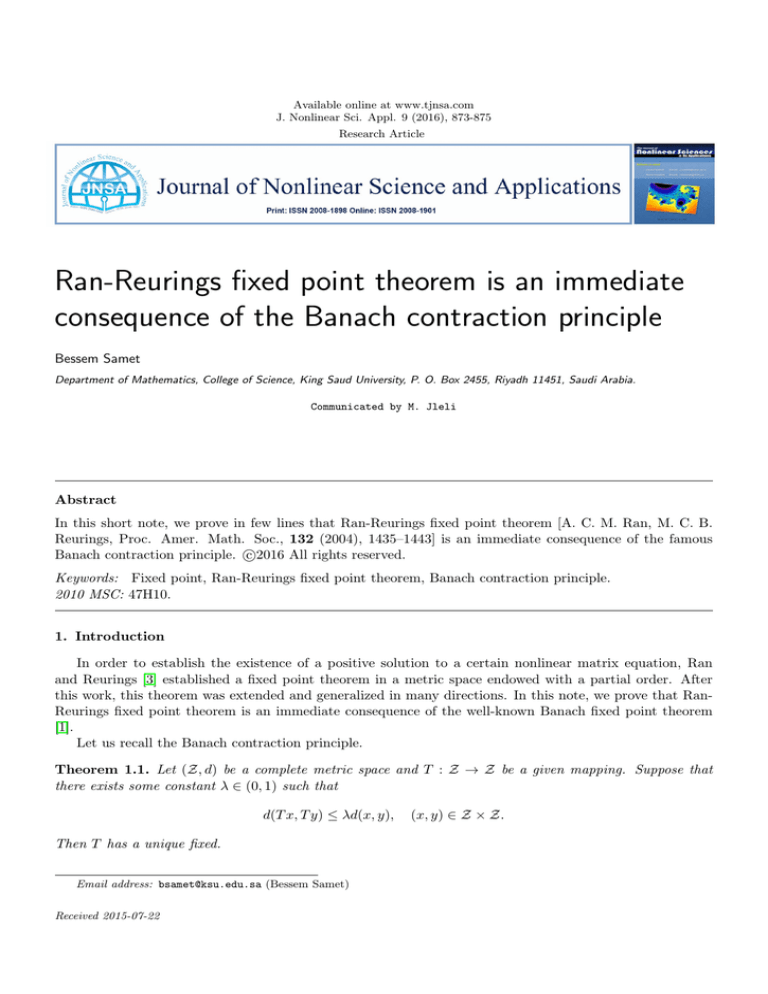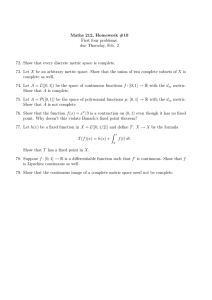
Available online at www.tjnsa.com
J. Nonlinear Sci. Appl. 9 (2016), 873-875
Research Article
Ran-Reurings fixed point theorem is an immediate
consequence of the Banach contraction principle
Bessem Samet
Department of Mathematics, College of Science, King Saud University, P. O. Box 2455, Riyadh 11451, Saudi Arabia.
Communicated by M. Jleli
Abstract
In this short note, we prove in few lines that Ran-Reurings fixed point theorem [A. C. M. Ran, M. C. B.
Reurings, Proc. Amer. Math. Soc., 132 (2004), 1435–1443] is an immediate consequence of the famous
c
Banach contraction principle. 2016
All rights reserved.
Keywords: Fixed point, Ran-Reurings fixed point theorem, Banach contraction principle.
2010 MSC: 47H10.
1. Introduction
In order to establish the existence of a positive solution to a certain nonlinear matrix equation, Ran
and Reurings [3] established a fixed point theorem in a metric space endowed with a partial order. After
this work, this theorem was extended and generalized in many directions. In this note, we prove that RanReurings fixed point theorem is an immediate consequence of the well-known Banach fixed point theorem
[1].
Let us recall the Banach contraction principle.
Theorem 1.1. Let (Z, d) be a complete metric space and T : Z → Z be a given mapping. Suppose that
there exists some constant λ ∈ (0, 1) such that
d(T x, T y) ≤ λd(x, y),
Then T has a unique fixed.
Email address: bsamet@ksu.edu.sa (Bessem Samet)
Received 2015-07-22
(x, y) ∈ Z × Z.
B. Samet, J. Nonlinear Sci. Appl. 9 (2016), 873-875
874
Let X be a nonempty set endowed with a partial order .
Definition 1.2. We say that T : X → X is non-decreasing with respect to the partial order if
(x, y) ∈ X × X, x y =⇒ T x T y.
Ran and Reurings [3] established the following result.
Theorem 1.3. Let (X, d) be a complete metric space endowed with a partial order . Let T : X → X be a
continuous and non-decreasing mapping with respect to . Suppose that there exists some constant λ ∈ (0, 1)
such that
d(T x, T y) ≤ λd(x, y), (x, y) ∈ X × X, x y.
If there exists some x0 ∈ X such that x0 T x0 , then T has a fixed point.
2. Discussion
Now, we prove that
Theorem 1.1 =⇒ Theorem 1.3.
Let us consider the subset ΛT (x0 ) of X defined by
ΛT (x0 ) = {T n x0 : n = 0, 1, 2, · · · }.
Let
Z = ΛT (x0 )
be the closure of ΛT (x0 ) with respect to the metric d. Clearly, (Z, d) is a complete metric space. We claim
that
T (Z) ⊆ Z.
Let z ∈ Z. From the definition of Z, there exists a sequence {T nk x0 }k that converges to z with respect to
the metric d. The continuity of T yields {T nk +1 x0 }k converges to T z with respect to the metric d. Since
{T nk +1 x0 }k ⊆ Z and Z is closed, then T z ∈ Z, which proves our claim.
Now, let (x, y) be an arbitrary pair of points in Z × Z. From the definition of Z, there exists a sequence
{T nk x0 }k that converges to x with respect to the metric d. Similarly, there exists a sequence {T np x0 }p that
converges to y with respect to the metric d. On the other hand, the monotony of T yields
x0 T x0 T 2 x0 · · · T n x0 T n+1 x0 · · · .
Then T nk x0 and T np x0 are comparable with respect to the partial order for every natural numbers p and
k. Thus we have
d(T nk +1 x0 , T np +1 x0 ) ≤ λd(T nk x0 , T np x0 ), for all k, p.
Letting k → ∞ and p → ∞ in the above inequality, using the continuity of T and the metric d, we obtain
d(T x, T y) ≤ λd(x, y).
As a consequence, we have
d(T x, T y) ≤ λd(x, y),
(x, y) ∈ Z × Z.
Finally, the Banach contraction principle (Theorem 1.1) gives us the existence of a unique fixed point of T
in Z. Note that the uniqueness is obtained just in the subspace Z of X. So, T has at least one fixed point
in the hole space X. This ends the proof.
Remark that our strategy can be used for many other types of contractions in partially ordered metric
spaces under the continuity assumption of the considered mapping. For example, let us consider the Kannan
fixed point theorem [2].
B. Samet, J. Nonlinear Sci. Appl. 9 (2016), 873-875
875
Theorem 2.1. Let (Z, d) be a complete metric space and T : Z → Z be a given mapping. Suppose that
there exists some constant λ ∈ (0, 1/2) such that
d(T x, T y) ≤ λ[d(x, T x) + d(y, T y)],
(x, y) ∈ Z × Z.
Then T has a unique fixed.
Using our strategy, we deduce immediately from Theorem 2.1 the following version of Kannan fixed
point theorem in partially ordered metric spaces.
Corollary 2.2. Let (X, d) be a complete metric space endowed with a partial order . Let T : X → X
be a continuous and non-decreasing mapping with respect to . Suppose that there exists some constant
λ ∈ (0, 1/2) such that
d(T x, T y) ≤ λ[d(x, T x) + d(y, T y)],
(x, y) ∈ X × X, x y.
If there exists some x0 ∈ X such that x0 T x0 , then T has a fixed point.
Acknowledgements:
The author would like to extend his sincere appreciation to the Deanship of Scientific Research at King
Saud University for its funding of this Prolific Research Group Project No. PRG-1436-10.
References
[1] S. Banach, Sur les opérations dans les ensembles abstraits et leur applications aux équations intégrales, Fundam.
Math., 3 (1922), 133–181. 1
[2] R. Kannan, Some results on fixed points, Bull. Calcutta Math. Soc., 60 (1968), 71–76. 2
[3] A. C. M. Ran, M. C. B. Reurings, A fixed point theorem in partially ordered sets and some applications to matrix
equations, Proc. Amer. Math. Soc., 132 (2004), 1435–1443. 1, 1




